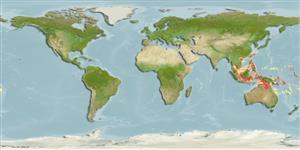>
Perciformes/Scorpaenoidei (Scorpionfishes) >
Aploactinidae (Velvetfishes)
Etymology: Xenaploactis: Greek, xenos = strange + Greek, aplos = double + Greek, aktis, -inos = ray (Ref. 45335); cautes: Name means a rough, pointed rock [= cautes]. Noun in apposition..
Environment: milieu / climate zone / depth range / distribution range
Ecología
marino demersal; rango de profundidad 33 - 79 m (Ref. 35984). Tropical
Indo-western Pacific: Gulf of Thailand.
Tamaño / Peso / Age
Maturity: Lm ? range ? - ? cm
Max length : 2.8 cm SL macho / no sexado; (Ref. 35984)
Short description
Morfología | Morfometría
Espinas dorsales (total): 14; Radios blandos dorsales (total): 8-9; Espinas anales 1; Radios blandos anales: 10; Vértebra: 27 - 28. Body densely covered with modified scales which form spinous points; depth less than 1/3 SL.. Lachrymal with 3 strong sharp spines, the first of moderate size , points mostly forward, continuous with ridge at base of larger 2nd spine (about equal in length to 3rd), directed downward, slightly curved; 3rd spine points mostly back. Second infraorbital bone with 2 spines, 1 above other, with obscure circular lateral line pore. Interorbit with nearly parallel ridges, stronger posteriorly (Ref. 35984, 39602).
Occurs on soft bottom. Benthic (Ref. 75154).
Life cycle and mating behavior
Madurez | Reproducción | Puesta | Huevos | Fecundidad | Larva
Poss, S.G. and W.N. Eschmeyer, 1980. Xenaploactis, a new genus for Prosopodasys asperrimus Günther (Pisces: Aploactinidae), with descriptions of two new species. Proc. Calif. Acad. Sci. 42(8):287-293. (Ref. 35984)
IUCN Red List Status (Ref. 130435)
Threat to humans
Harmless
Human uses
Más información
Nombres comunesSinónimosMetabolismoDespredadoresEcotoxicologíaReproducciónMadurezPuestaAgregación para la puestaFecundidadHuevosEgg development
Age/SizeCrecimientoLength-weightLength-lengthLength-frequenciesMorfometríaMorfologíaLarvaDinámica larvariaReclutamientoAbundanciaBRUVS
ReferenciasAcuiculturaPerfil de acuiculturaRazasGenéticaElectrophoresesheritabilidadEnfermedadesProcesamientoNutrientsMass conversion
ColaboradoresImágenesStamps, Coins Misc.SonidosCiguateraVelocidadTipo de nataciónSuperficie branquialOtolitosCerebrosVisión
Herramientas
Special reports
Download XML
Fuentes de Internet
Estimates based on models
Preferred temperature (Ref.
123201): 26.1 - 28.6, mean 27.5 °C (based on 267 cells).
Phylogenetic diversity index (Ref.
82804): PD
50 = 0.6250 [Uniqueness, from 0.5 = low to 2.0 = high].
Bayesian length-weight: a=0.01000 (0.00244 - 0.04107), b=3.04 (2.81 - 3.27), in cm total length, based on all LWR estimates for this body shape (Ref.
93245).
Nivel trófico (Ref.
69278): 3.1 ±0.4 se; based on size and trophs of closest relatives
Fishing Vulnerability (Ref.
59153): Low vulnerability (10 of 100).
